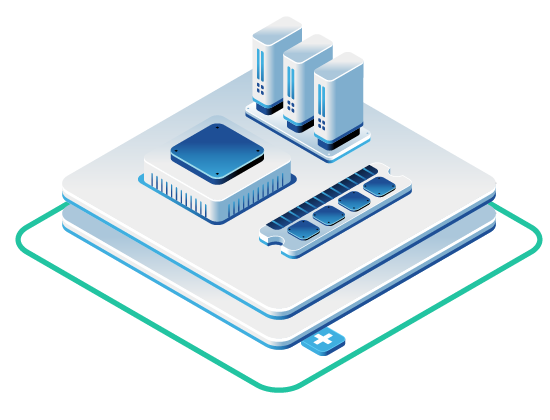In this blog
- The Benefits of Dynamic Workload Consolidation
- How Dynamic Workload Consolidation Works
- Core Metrics to Gauge Your Success
- Strategies for Effective Workload Consolidation
- Balancing Performance with Energy Savings
- Implementation Roadmap: Getting Started with DWC
- Free Download: Dynamic Workload Consolidation Implementation Checklist
- Wrapping Up: Smart Consolidation, Tangible Savings
Energy consumption is a growing concern, both environmentally and for your bottom line. If you’re running a private cloud, you’re likely looking for practical ways to reduce power usage and spend without compromising performance. Dynamic Workload Consolidation (DWC) offers a solution. This strategy intelligently reallocates virtual machine (VM) workloads, powering down unused servers and cutting operational expenses.
This guide will walk you through what DWC is, how it operates, and how you can implement it to achieve energy and cost savings, particularly when supported by flexible infrastructure like an OpenMetal private cloud.
The Benefits of Dynamic Workload Consolidation
Implementing DWC is about more than just being green; it’s about smart resource management that translates directly into savings and operational improvements.
- Reduced Cloud Expenses: Businesses can see cloud infrastructure spend drop by optimizing server use, especially as energy costs grow.
- Better Energy Utilization: Properly managed private clouds can achieve impressive gains in energy conservation.
- Sustained Performance: DWC aims to reduce energy use while minimizing service disruptions, keeping your applications responsive.
How Dynamic Workload Consolidation Works
At its heart, DWC is a continuous optimization loop:
- Monitor Resource Usage: The system constantly tracks CPU, memory, network, and storage demands across your server fleet.
- Identify Idle or Underused Servers: Based on predefined thresholds or algorithmic analysis, the system pinpoints servers not pulling their weight.
- Redistribute VMs: Workloads (VMs) from underused servers are live-migrated to other active servers that have spare capacity.
- Power Down Unused Servers: Once a server’s VMs are relocated and it’s truly idle, it’s powered down to save energy. It can be quickly powered back on when demand spikes.
Core Metrics to Gauge Your Success
To effectively manage DWC, you need to track a few key performance indicators:
- Power Usage Effectiveness (PUE): Calculated as PUE=IT Equipment Energy/Total Facility Energy. A PUE closer to 1.0 indicates high efficiency in your data center or server environment.
- Server Utilization Rate (SUR): This measures the percentage of server capacity being actively used. DWC aims to increase SUR on active servers, allowing others to be powered down.
- Energy Consumption per VM (ECVM): This metric helps assess the energy footprint of individual workloads, guiding more granular consolidation decisions.
- Response Time Impact (RTI): While consolidating, it’s important to monitor application response times to ensure that energy savings don’t come at the cost of user experience.
Strategies for Effective Workload Consolidation
Making DWC work involves a combination of intelligent algorithms, precise energy tracking, and the right kind of infrastructure.
1. Consolidation Algorithms
Smart decision-making is the engine of DWC. Common approaches include:
- Heuristic Methods: Rule-based systems that make quick decisions based on current conditions (e.g., “if server CPU is below X% for Y minutes, migrate VMs”).
- Threshold-based Monitoring: Setting specific upper and lower bounds for resource usage on servers to trigger VM migrations or power state changes.
- Machine Learning-driven Analytics: More advanced systems use ML to predict future loads, identify subtle patterns of underutilization, and make more proactive consolidation choices.
These algorithms thrive on infrastructure that provides deep visibility and control which are two hallmarks of a well-designed private cloud.
2. Hardware and Infrastructure Choices
The underlying hardware and its management are foundational. An OpenMetal private cloud, built on bare metal servers, gives you the direct control needed to implement DWC effectively. Unlike opaque public clouds, you’re not guessing about underlying contention or resource availability. This level of control means you can:
- Full Tap Into Hardware: Ensure you’re getting the most out of every powered-on server.
- Implement Granular Power Management: Directly manage server power states.
- Benefit from Predictable Costs: With OpenMetal, you get fixed hardware budgets, eliminating the surprise bills often associated with fluctuating public cloud usage, making the ROI from energy savings even clearer.
As Chris Ueland, Co-Founder and CEO of Hunt Intelligence, noted about such private cloud setups, they are “The go-to option for battling the high costs of public clouds.”
3. Dynamic Resource Allocation
This is the active part of DWC—quickly redistributing VM resources to meet changing demands. The goal is to match resource supply with actual demand, avoiding over-provisioning. This is where the elasticity of a cloud platform shines, allowing you to scale resources up or down. OpenMetal’s ability to deploy new environments quickly (in as little as 45 seconds) means your capacity can rapidly adapt.
Balancing Performance with Energy Savings
A common concern with workload consolidation is its potential impact on application performance. However, when implemented correctly, DWC can maintain or even improve system responsiveness.
This balance is achieved through careful Service Level Management:
- Continuous Performance Monitoring: Keep a close eye on the RTI and other performance metrics.
- Automated Scaling Policies: Define rules that adjust resource allocation based on real-time demand, ensuring VMs get the resources they need.
- Predefined Thresholds: Establish clear limits for resource usage that trigger consolidation actions, ensuring you don’t over-consolidate and starve applications.
With comprehensive monitoring and the ability to dynamically allocate resources, you can achieve substantial energy savings without negatively affecting reliability or user satisfaction.
Implementation Roadmap: Getting Started with DWC
Ready to start saving? Here’s a step-by-step approach:
Assessment Phase
- Analyze your current server utilization patterns. Identify peak and off-peak loads.
- Benchmark your current energy consumption and PUE.
- Identify candidate workloads for consolidation (those that are less sensitive to minor latency changes or have variable demand).
Infrastructure Setup and Tooling
- Ensure your private cloud environment supports live migration of VMs and remote power management of servers. Platforms like OpenMetal are designed for this level of control.
- Choose your DWC management tools. This could be built-in features of your virtualization platform (like VMware DRS or OpenStack’s Watcher) or third-party solutions. Open source tools offer customization and can be tailored to your needs.
Policy Definition and Configuration
- Define your consolidation policies: What are the CPU/memory/network utilization thresholds for triggering VM migrations?
- Set power management policies: How long should a server be idle before it’s powered down?
- Configure safety margins to prevent over-consolidation and performance degradation.
Pilot Program and Rollout
- Start with a small, non-critical group of servers and workloads.
- Monitor closely, measuring energy savings against performance metrics.
- Refine your policies based on the pilot results.
- Gradually expand DWC across your infrastructure.
Ongoing Optimization
- DWC is not a “set it and forget it” solution. Regularly review your metrics and tweak policies.
- As your workloads evolve, your DWC strategy may also need to adapt.
Addressing Potential Hurdles
While powerful, DWC will likely present some technical considerations:
- Resource Contention: If too many VMs are packed onto too few servers, performance can suffer. Careful policy setting and monitoring are key.
- Migration Overhead: Live migration consumes some network bandwidth and CPU resources. Schedule migrations during off-peak hours where possible.
- Monitoring Complexity: Tracking all the necessary metrics requires capable monitoring tools and expertise.
Solutions lie in phased implementation, thorough testing, and choosing an infrastructure provider like OpenMetal that simplifies the underlying complexity and provides knowledgeable support.
📃 Take This Info With You – Download our Dynamic Workload Consolidation Implementation Checklist (opens in Google Docs) >>
Wrapping Up: Smart Consolidation, Tangible Savings
Dynamic Workload Consolidation is a proven strategy for reducing energy consumption and operational costs in private cloud environments. By intelligently managing your resources, you improve server utilization, cut down on wasted power, and contribute to a more sustainable IT operation.
Research continues to refine DWC with advancements in machine learning for predictive workload placement and more sophisticated energy-aware scheduling algorithms. The goal remains a perfect balance: maximum energy savings with guaranteed performance.
Platforms like OpenMetal’s private cloud provide the ideal foundation for DWC. With direct bare metal access, predictable costs, rapid deployment capabilities, and the flexibility of open source technologies, you gain the control needed to:
- Take full advantage of your hardware.
- Deploy and adjust environments on the fly to meet demand.
- Operate with clear, predictable hardware budgets.
- Simplify overall resource management.
Pair effective workload consolidation strategies with the right infrastructure and your organization can achieve impressive energy efficiency, consistent performance, and cost reductions.
Read More on the OpenMetal Blog


































